In the heart of Palermo
The Locanda del Gagini is located in the heart of the city, a few steps from the popular “Vucciria” market, and between the Teatro Massimo and the Teatro Politeama, prestigious theatres at international level. Very close there are numerous museums and art galleries and fine shops of the most famous brands.
Walking you can go to the shopping district of Via Ruggero Settimo, and among the clubs of Palermo’s “movida“.
Locanda del Gagini is a fifteen-minute walk from the central station and bus station, five minutes from the shuttle bus stop to/from Palermo’s Falcone-Borsellino airport and 600 metres from the seaport.
Also very close is the bus stop that allows you to go to the beautiful beach of Mondello, a wonderful place where you can enjoy the sun and the sea even out of season, thanks to the mild Sicilian weather.
❯ Our staff will be glad to give you any information about our city.
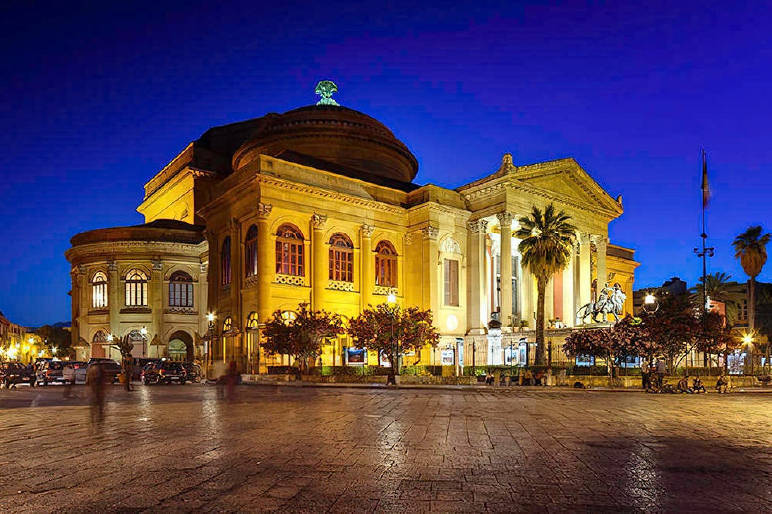
The largest theatre in Italy...
The Teatro Massimo in Palermo is the largest opera house in Italy, one of the largest in Europe and the third largest in terms of architectural size after the Opéra National in Paris and the Staatsoper in Vienna. State rooms, halls, galleries and monumental staircases surround the theatre proper, forming an architectural complex of enormous proportions.
The exterior of the theatre features a hexastyle Corinthian pronaos raised on a monumental staircase, at the sides of which are two bronze lions with the allegories of Tragedy by sculptor Benedetto Civiletti and Lyricism by sculptor Mario Rutelli. The building is topped by an enormous hemispherical dome.

The largest theatre in Italy...
The Teatro Massimo in Palermo is the largest opera house in Italy, one of the largest in Europe and the third largest in terms of architectural size after the Opéra National in Paris and the Staatsoper in Vienna. State rooms, halls, galleries and monumental staircases surround the theatre proper, forming an architectural complex of enormous proportions.
The exterior of the theatre features a hexastyle Corinthian pronaos raised on a monumental staircase, at the sides of which are two bronze lions with the allegories of Tragedy by sculptor Benedetto Civiletti and Lyricism by sculptor Mario Rutelli. The building is topped by an enormous hemispherical dome.
The fascinating theatre "of the people"...
The Politeama Theatre in Palermo, designed by the architect Giuseppe Damiani Almejda, is a harmonious and imposing building in Pompeian style located in Piazza Ruggero Settimo, one of the most beautiful and lively squares in the city.
The Politeama Theatre was the first in order of time to be built in the new city, in fact its construction began in 1867, almost at the same time as the construction of the larger and more imposing Massimo Theatre, and ended in 1891 at the behest of the city’s municipal administration. The enormous hall, arranged in a horseshoe shape, and the way it was conceived, was intended to enhance the theatre’s social function, i.e. that of ‘Theatre of the People’.
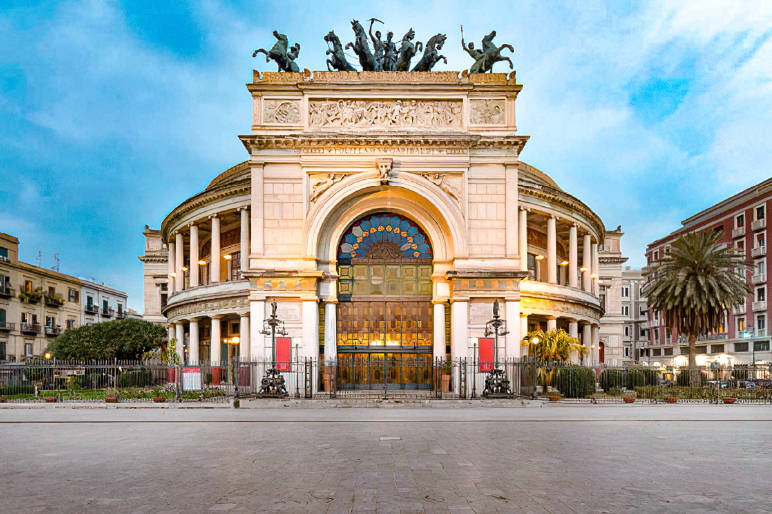

The fascinating theatre "of the people"...
The Politeama Theatre in Palermo, designed by the architect Giuseppe Damiani Almejda, is a harmonious and imposing building in Pompeian style located in Piazza Ruggero Settimo, one of the most beautiful and lively squares in the city.
The Politeama Theatre was the first in order of time to be built in the new city, in fact its construction began in 1867, almost at the same time as the construction of the larger and more imposing Massimo Theatre, and ended in 1891 at the behest of the city’s municipal administration. The enormous hall, arranged in a horseshoe shape, and the way it was conceived, was intended to enhance the theatre’s social function, i.e. that of ‘Theatre of the People’.

The treasure of the Cathedral...
Palermo Cathedral is one of the city’s most characteristic buildings, its originality deriving from the mixture of different forms and styles in a single architectural body. It is the result of the multiple populations that have alternated on Sicilian soil over the centuries. The Cathedral was built in 1184 by Archbishop Gualtiero Offamilio.
The reconstructed interior, designed by Ferdinando Fuga, has a Latin cross plan with three naves. It houses the remains of Sicilian royalty, including Frederick II and Roger II, and those of Santa Rosalia, patron saint of Palermo. Other tombs can be found in the 6th-century crypt. In the Treasury rooms you can admire the golden tiara of Queen Constance of Aragon, along with other precious objects found in the royal tombs.

The treasure of the Cathedral...
Palermo Cathedral is one of the city’s most characteristic buildings, its originality deriving from the mixture of different forms and styles in a single architectural body. It is the result of the multiple populations that have alternated on Sicilian soil over the centuries. The Cathedral was built in 1184 by Archbishop Gualtiero Offamilio.
The reconstructed interior, designed by Ferdinando Fuga, has a Latin cross plan with three naves. It houses the remains of Sicilian royalty, including Frederick II and Roger II, and those of Santa Rosalia, patron saint of Palermo. Other tombs can be found in the 6th-century crypt. In the Treasury rooms you can admire the golden tiara of Queen Constance of Aragon, along with other precious objects found in the royal tombs.
Traditions, food, and street art...
Inside the district ‘Palazzo Reale or Albergheria’, bordered by Corso Tukory on one side and Via Maqueda on the other, there are stalls overflowing with merchandise, spicy aromas, scents and colours of fruit and vegetables arranged in a scenographic way, you can hear the “abbanniata”, the call of the vendors to attract potential buyers. We are in Palermo, in the historic Ballarò market, which suffers from the cultural legacy of the Arab presence.
Ballarò is the liveliest, most dynamic and longest market in the city, and its name probably derives from “Balhara”, an Islamic village near Monreale, where the vendors lived and who daily “descended” to Balarm to sell their wares at Ballarò.
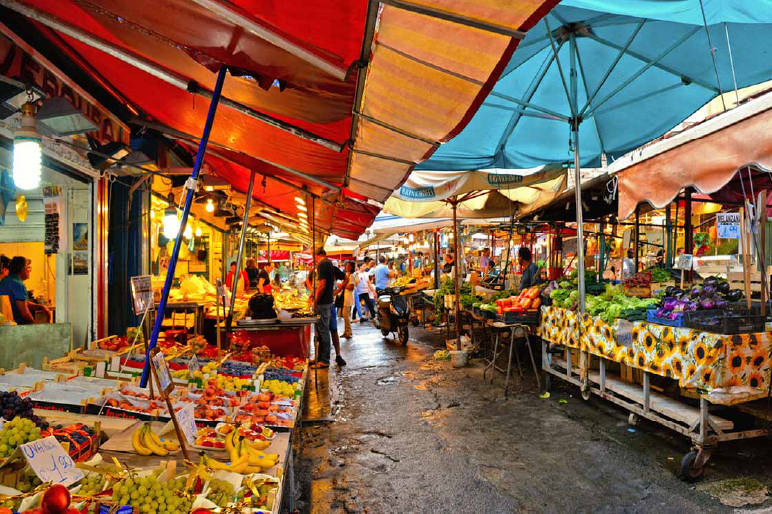

Traditions, food, and street art...
Inside the district ‘Palazzo Reale or Albergheria’, bordered by Corso Tukory on one side and Via Maqueda on the other, there are stalls overflowing with merchandise, spicy aromas, scents and colours of fruit and vegetables arranged in a scenographic way, you can hear the “abbanniata”, the call of the vendors to attract potential buyers. We are in Palermo, in the historic Ballarò market, which suffers from the cultural legacy of the Arab presence.
Ballarò is the liveliest, most dynamic and longest market in the city, and its name probably derives from “Balhara”, an Islamic village near Monreale, where the vendors lived and who daily “descended” to Balarm to sell their wares at Ballarò.
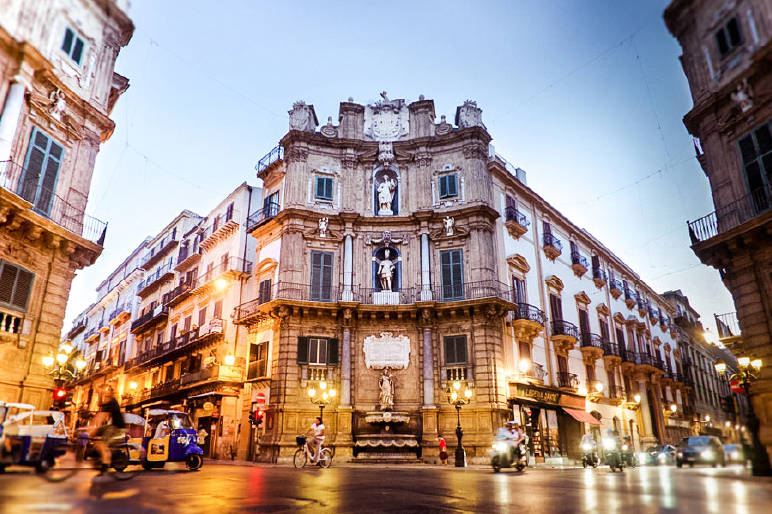
The heart of the city...
Palermo’s Piazza of Quattro Canti is not only one of the city’s most beautiful sights. It is a condensation of its ancient and modern history and is the ideal starting point for learning about the origins of the Sicilian capital and its oldest quarters.
It is also known as Piazza Villena, as the Octagon of the Sun, as the Theatre of the Sun and as the Theatre of the City, but for all Palermo residents it is just the Quattro Canti. The square was created at the intersection of Palermo’s two central streets: Via Maqueda on one side and Corso Vittorio Emanuele on the other. The result was an octagonal square, embellished in the 17th century by sculptures and decorations on the facades of the four buildings on either side of the square.

The heart of the city...
Palermo’s Piazza of Quattro Canti is not only one of the city’s most beautiful sights. It is a condensation of its ancient and modern history and is the ideal starting point for learning about the origins of the Sicilian capital and its oldest quarters.
It is also known as Piazza Villena, as the Octagon of the Sun, as the Theatre of the Sun and as the Theatre of the City, but for all Palermo residents it is just the Quattro Canti. The square was created at the intersection of Palermo’s two central streets: Via Maqueda on one side and Corso Vittorio Emanuele on the other. The result was an octagonal square, embellished in the 17th century by sculptures and decorations on the facades of the four buildings on either side of the square.
One of the wonders of Palermo...
An essential stop on any Arab-Norman itinerary in the city of Palermo is the Church of Martorana, which hides a triumph of mosaics and fascinating decorations behind a simple, linear facade.
The cycle of mosaics that adorns the Church of the Martorana was completed in 1151: it is the oldest in all of Sicily and has immeasurable artistic value. The centrepiece of this artistic composition is the image of Christ Pantocrator in the dome, with four prostrate angels at his feet in the act of adoration. The church is not only unique in its beauty, but also in its religious function: it is the reference point for more than 15,000 Albanian faithful of the Greek-Byzantine religious rite in our nation.
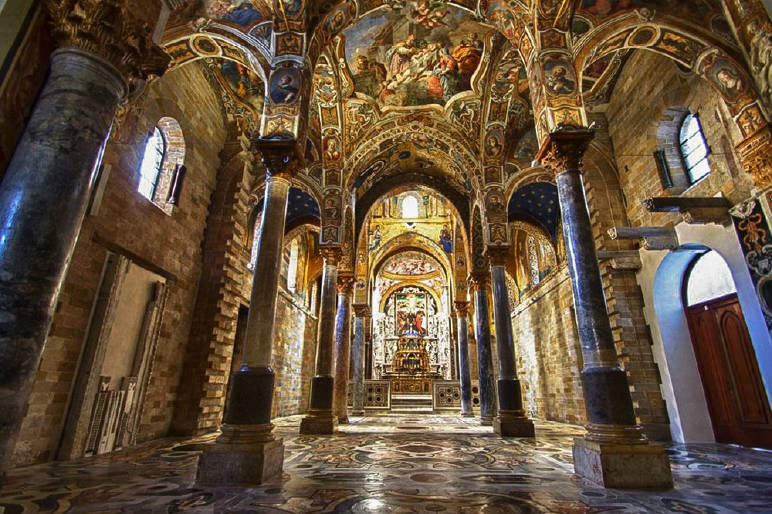

One of the wonders of Palermo...
An essential stop on any Arab-Norman itinerary in the city of Palermo is the Church of Martorana, which hides a triumph of mosaics and fascinating decorations behind a simple, linear facade.
The cycle of mosaics that adorns the Church of the Martorana was completed in 1151: it is the oldest in all of Sicily and has immeasurable artistic value. The centrepiece of this artistic composition is the image of Christ Pantocrator in the dome, with four prostrate angels at his feet in the act of adoration. The church is not only unique in its beauty, but also in its religious function: it is the reference point for more than 15,000 Albanian faithful of the Greek-Byzantine religious rite in our nation.
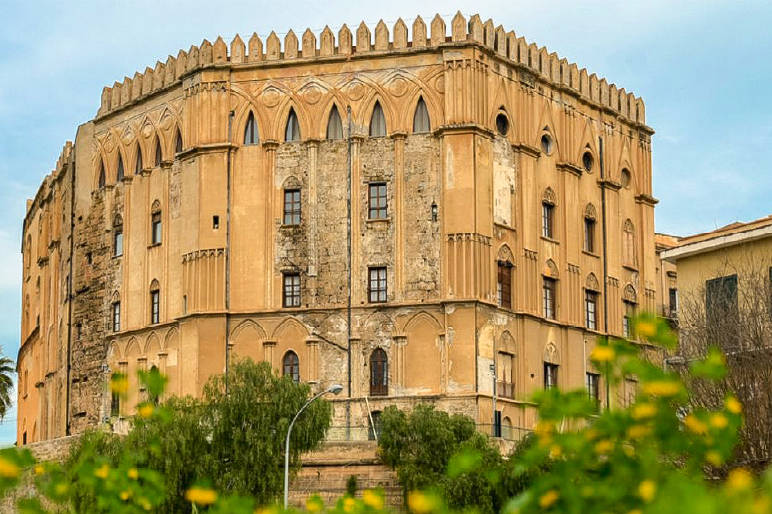
The Royal Palace of Palermo...
The Palace of Normans, also known as the Royal Palace, is one of Palermo’s main monuments. The fortress built by the Arabs in the 9th Century, was transformed and enlarged by the Normans who made it the centre of their power.
Its architectural style is cosmopolitan and retains traces of the different cultures that have inhabited it. But the jewel of the Norman palace is the Palatine Chapel with its spectacular golden mosaics, a masterpiece in the Arab-Norman-Byzantine style. The chapel was commissioned by King Roger II to host masses for the royal family. It is the most beautiful Byzantine chapel in Palermo and is considered by many to be the most beautiful church in Sicily.

The Royal Palace of Palermo...
The Palace of Normans, also known as the Royal Palace, is one of Palermo’s main monuments. The fortress built by the Arabs in the 9th Century, was transformed and enlarged by the Normans who made it the centre of their power.
Its architectural style is cosmopolitan and retains traces of the different cultures that have inhabited it. But the jewel of the Norman palace is the Palatine Chapel with its spectacular golden mosaics, a masterpiece in the Arab-Norman-Byzantine style. The chapel was commissioned by King Roger II to host masses for the royal family. It is the most beautiful Byzantine chapel in Palermo and is considered by many to be the most beautiful church in Sicily.
The Fountain of Shame...
Its real name is Praetorian Fountain, but Sicilians call it Fountain of Shame because of the nudity of the statues that compose it: it is one of the most representative symbols of the Sicilian capital and is located in the square of the same name. It has long been regarded by the people of Palermo as a symbol of the corruption and malpractice of some representatives of 18th and 19th century civil and political life.
It is considered one of the most beautiful fountains in Italy. Built in 1554 by Francesco Camillani in Florence, it was later moved to Praetorian sqaure in Palermo in 1581. It is said that the nobleman Don Luigi Toledo, father-in-law of Cosimo I de Medici Grand Duke of Tuscany, decided to embellish the garden of his villa in Florence with such fountain.
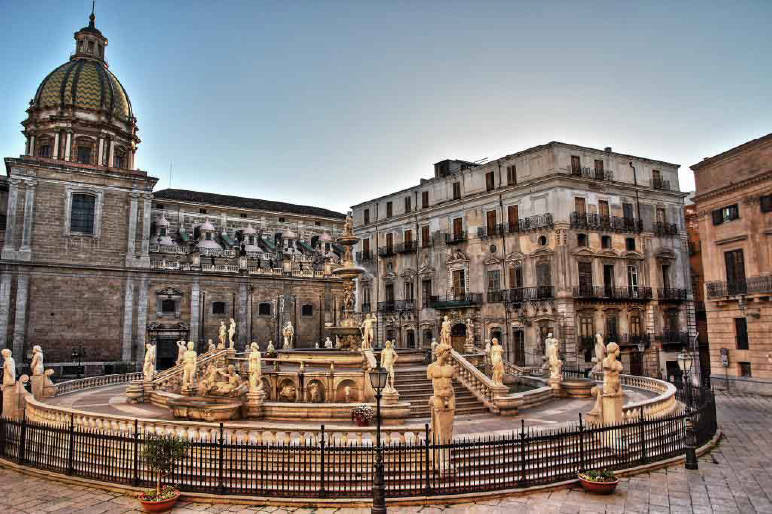

The Fountain of Shame...
Its real name is Praetorian Fountain, but Sicilians call it Fountain of Shame because of the nudity of the statues that compose it: it is one of the most representative symbols of the Sicilian capital and is located in the square of the same name. It has long been regarded by the people of Palermo as a symbol of the corruption and malpractice of some representatives of 18th and 19th century civil and political life.
It is considered one of the most beautiful fountains in Italy. Built in 1554 by Francesco Camillani in Florence, it was later moved to Praetorian sqaure in Palermo in 1581. It is said that the nobleman Don Luigi Toledo, father-in-law of Cosimo I de Medici Grand Duke of Tuscany, decided to embellish the garden of his villa in Florence with such fountain.
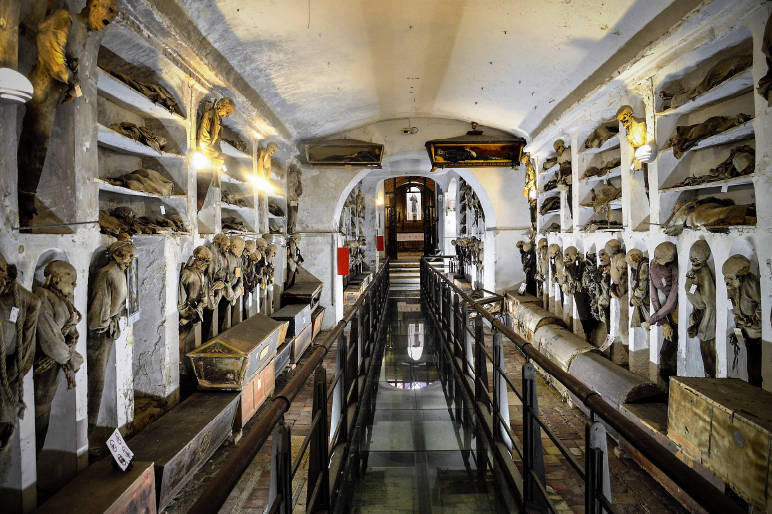
A unique place...
The state of conservation of the uncountable corpses on display makes the cemetery of the Convent of the Capuchin Friars, known as the Capuchins Catacombs of Palermo, one of the most impressive places to visit in the world.
A macabre spectacle that highlights the customs and traditions of Palermo society as it lived from the 17th to the 19th century. A unique cultural heritage that over many centuries has attracted curious people from all over the world, including many intellectuals, poets and writers such as Alexandre Dumas, Mario Praz, Guy de Maupassant, Fanny Lewald and Carlo Levi. Even Ippolito Pindemonte did not remain insensitive to this evocative place, praising it in the verses of his “Sepulchres”.

A unique place...
The state of conservation of the uncountable corpses on display makes the cemetery of the Convent of the Capuchin Friars, known as the Capuchins Catacombs of Palermo, one of the most impressive places to visit in the world.
A macabre spectacle that highlights the customs and traditions of Palermo society as it lived from the 17th to the 19th century. A unique cultural heritage that over many centuries has attracted curious people from all over the world, including many intellectuals, poets and writers such as Alexandre Dumas, Mario Praz, Guy de Maupassant, Fanny Lewald and Carlo Levi. Even Ippolito Pindemonte did not remain insensitive to this evocative place, praising it in the verses of his “Sepulchres”.
The palace "of the splendid"...
The Zisa Castle, begun during the reign of William I and completed by William II around 1167, was the favourite summer residence of the kings and his court. Its name comes from the Arabic ‘al-Aziz’, meaning ‘splendid’. Over the centuries it has undergone several transformations, the most notable being in 1635, when additions were made in the Baroque style by Giovanni Sandoval.
The original Zisa was part of the great royal hunting park of the Genoard (Paradise of the Earth), which extended to the west of the city. All the royal buildings within it were surrounded by beautiful gardens, watered and embellished with fountains and large ponds, also used as fishponds.
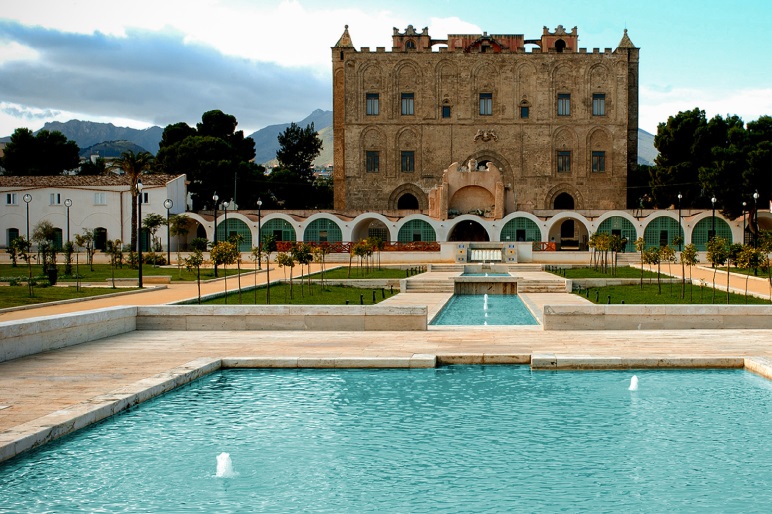

The palace "of the splendid"...
The Zisa Castle, begun during the reign of William I and completed by William II around 1167, was the favourite summer residence of the kings and his court. Its name comes from the Arabic ‘al-Aziz’, meaning ‘splendid’. Over the centuries it has undergone several transformations, the most notable being in 1635, when additions were made in the Baroque style by Giovanni Sandoval.
The original Zisa was part of the great royal hunting park of the Genoard (Paradise of the Earth), which extended to the west of the city. All the royal buildings within it were surrounded by beautiful gardens, watered and embellished with fountains and large ponds, also used as fishponds.
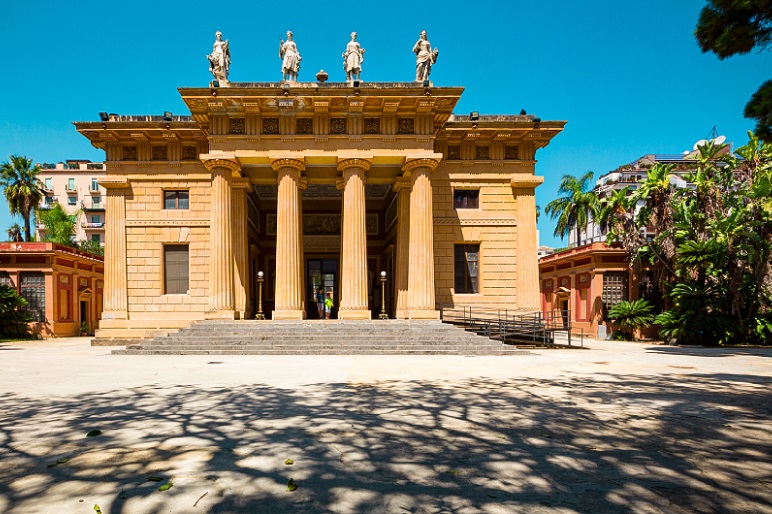
The tropics in the Mediterranean...
A few steps throw from the sea at the Foro Italico in Palermo is a large, lush garden, rich in fascinating species. This garden is one of the largest in Europe and one of the most prestigious. Strolling along its avenues, one has the feeling of being inside a large museum where plants reign supreme.
Palermo’s Botanical Garden boasts over two hundred years of activity: thanks to that activity, today we have many plant species in the Mediterranean basin that originate in tropical and subtropical regions. It is a place of rare beauty, which Johann Wolfgang Goethe described: “In this public garden, I spent hours of sweetest tranquillity”. Today, the Botanical Garden is the richest in Italy and among the first in Europe.

The tropics in the Mediterranean...
A few steps throw from the sea at the Foro Italico in Palermo is a large, lush garden, rich in fascinating species. This garden is one of the largest in Europe and one of the most prestigious. Strolling along its avenues, one has the feeling of being inside a large museum where plants reign supreme.
Palermo’s Botanical Garden boasts over two hundred years of activity: thanks to that activity, today we have many plant species in the Mediterranean basin that originate in tropical and subtropical regions. It is a place of rare beauty, which Johann Wolfgang Goethe described: “In this public garden, I spent hours of sweetest tranquillity”. Today, the Botanical Garden is the richest in Italy and among the first in Europe.
The most beautiful temple in the world...
Commissioned by the Norman King William II and built between 1154 and 1189, the Monreale Cathedral is one of the most imposing Norman monuments in Sicily, an authentic treasure chest of beauty and wonder created to affirm the power of King William II, known as The Good. An artistic achievement rich in history and charm, built during a war for power.
Anyone who has been to Palermo will certainly not have missed the appointment with this 12th-century medieval masterpiece, which is located a few kilometres from the Sicilian capital and is a significant work of art for the whole of mankind, so much so that it has become a UNESCO World Heritage Site.
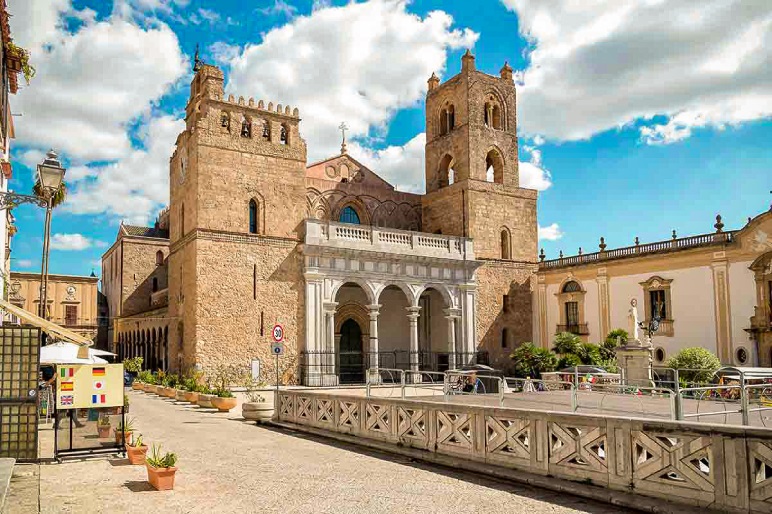

The most beautiful temple in the world...
Commissioned by the Norman King William II and built between 1154 and 1189, the Monreale Cathedral is one of the most imposing Norman monuments in Sicily, an authentic treasure chest of beauty and wonder created to affirm the power of King William II, known as The Good. An artistic achievement rich in history and charm, built during a war for power.
Anyone who has been to Palermo will certainly not have missed the appointment with this 12th-century medieval masterpiece, which is located a few kilometres from the Sicilian capital and is a significant work of art for the whole of mankind, so much so that it has become a UNESCO World Heritage Site.
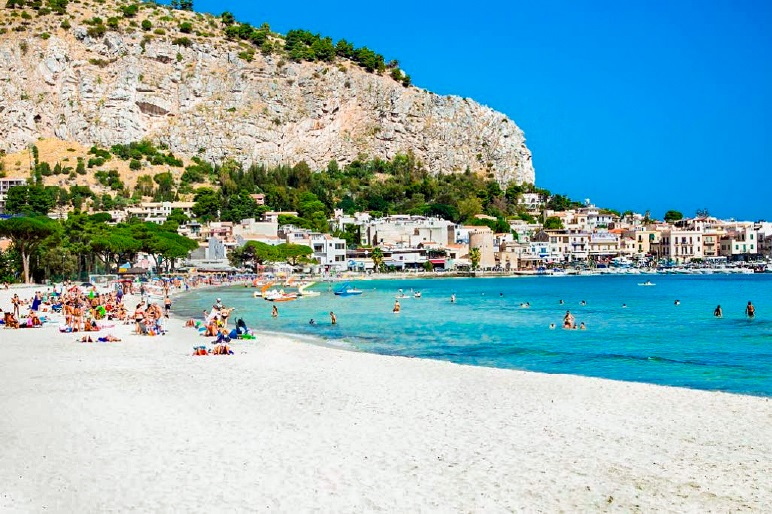
One of the most beautiful beaches...
Mondello beach is considered one of the most beautiful and suggestive beaches in Palermo. It is only 11 km from the city centre and this proximity means that it is also frequented by those who have a few hours to spend at the beach. From the city centre you can walk along several tree-lined avenues until you reach this beautiful and popular beach, which can be reached either on foot or by public transport.
It is nestled between Monte Pellegrino and Monte Gallo, which add a touch of nature and greenery to the white beach, lapped by a crystal clear sea. Its solitary and wild beauty can be enjoyed all year round, while in the summer months it is transformed to welcome the many tourists who choose it for their seaside holidays.

One of the most beautiful beaches...
Mondello beach is considered one of the most beautiful and suggestive beaches in Palermo. It is only 11 km from the city centre and this proximity means that it is also frequented by those who have a few hours to spend at the beach. From the city centre you can walk along several tree-lined avenues until you reach this beautiful and popular beach, which can be reached either on foot or by public transport.
It is nestled between Monte Pellegrino and Monte Gallo, which add a touch of nature and greenery to the white beach, lapped by a crystal clear sea. Its solitary and wild beauty can be enjoyed all year round, while in the summer months it is transformed to welcome the many tourists who choose it for their seaside holidays.
